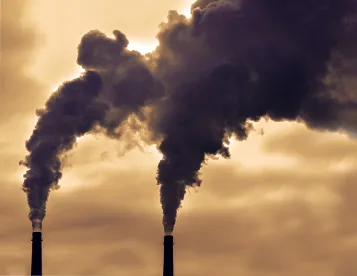After a long wait, the Treasury Department has issued proposed regulations to implement Section 45Q of the Tax Code, which provides tax credits for capturing and sequestering carbon oxides that would otherwise escape to the atmosphere and contribute to climate change. The eventual finalization of such rules may help to spur additional carbon capture and sequestration activities within the United States, and also may help to incentivize other forms of carbon sequestration.
Key Takeaways
-
Section 45Q provides tax credits of up to $50 per ton of carbon captured and placed in secure geological storage, and tax credits of up to $35 per ton of carbon injected into oil or natural gas wells for enhanced recovery (EOR), and for carbon captured and sequestered using photosynthetic or chemosynthesic processes or “for any other purpose for which a commercial market exists.”
-
The proposed regulations will, if adopted, provide the legal structure that would govern how taxpayers can claim these credits and how the Internal Revenue Service will enforce them.
-
The proposed regulations have some gaps. For example, they do not attempt to define the broadest potential application of the tax credits, where a “commercial market exists” for captured carbon. The proposed rules also are thin on detail with respect to granting credits for photosynthetic or chemosynthesic processes.
-
Interested parties may comment on the proposed regulations, and to suggest how as-yet undefined terms such as “commercial markets” should be defined in the final rules. Comments are due August 3, 2020.
Background on Section 45Q
The current version of Section 45Q was adopted on February 9, 2018, as part of the Bipartisan Budget Act of 2018. That legislation provided for a $20 per ton carbon credit for geological storage of carbon using equipment placed in service before the date of enactment, and $10 per ton for carbon used for enhanced oil or gas well recovery or “utilized” through photosynthetic or similar processes, or through “commercial markets” that capture and sequester carbon. If carbon capture uses equipment or a process placed in service after the date of enactment, carbon capture is eligible for a tax credit provided over a 12-year period beginning from the commercial operation date of the equipment or process. For geologic sequestration, the tax credit starts at $22.66 in 2017 and rises to $50 in 2027, with an inflation adjustment thereafter. For carbon injected for enhanced petroleum recovery or captured through a photosynthetic/chemosynthetic process or used in a commercial market, the tax credit starts at $12.83 per ton and rises to $35 per ton in 2027. The legislation also allows the tax credit to be transferred and for recapture of the tax credit if the sequestered carbon later reaches the atmosphere.
The Proposed Rule
The Treasury Department’s proposed 45Q rule sets forth requirements that would have to be met for each of the various paths for qualifying for the tax credit. With respect to geological storage, which is eligible for the larger tax credit, the proposed rule would require a taxpayer to meet U.S. EPA’s reporting rules governing geological sequestration of carbon dioxide (40 CFR Part 98, Subpart RR), including developing a Monitoring, Reporting, and Verification Plan to document the amounts of carbon injected and stored or else to meet applicable Underground Injection Control regulations.
Taxpayers injecting carbon oxides into oil or gas wells for purposes of tertiary production would have the choice of satisfying either the EPA regulations governing geological sequestration of carbon dioxide or CSA/ANSI ISO 27916:19, the standard for “Carbon dioxide capture, transportation and geological storage – Carbon dioxide storage using enhanced oil recovery (CO2-EOR)” that has been developed and endorsed by the International Organization for Standardization (ISO) and the American National Standards Institute (ANSI).
For taxpayers seeking credit for carbon “utilization” – the statutory term that includes carbon capture through photosynthetic and chemosynthetic processes and through carbon captured for “commercial markets” – the rules require that the amount of carbon captured and sequestered be demonstrated through a life-cycle carbon analysis meeting ISO 14044:2006 (“Environmental management — Life cycle assessment — Requirements and guidelines”) that has either been performed or verified by a qualified third party. The analysis must be submitted to both IRS and Department of Energy (DOE). The analysis will then undergo a technical review by the DOE, and the IRS, in consultation with the EPA, will decide whether to approve it. The proposed rules, however, specifically decline to provide a definition of “commercial market,” leaving this issue, which would provide the least restrictive path to obtaining tax credits under Section 45Q, to the future.
The rule also defines the ownership and transferability of the tax credit. The tax credit is assigned to the party that owns the carbon capture equipment or process, but the tax credit can be transferred to another party who is in the transactional chain that results in capture and storage of carbon, or use of the carbon as an injectant to enhance recovery of oil or natural gas. The rules allow the tax credit to be transferred individually in each tax year and also to be split and assigned to multiple parties. This should maximize the utility of the tax credits and allow them to be leveraged to support project financing, which has been a key to financing renewable energy projects under similar provisions of the Tax Code.
Finally, the rules define the circumstances under which the tax credit can be recaptured by the IRS because of leakage or removal of carbon from storage. The recapture period starts on the date the carbon capture system reaches commercial operation and ends on the later of five years after the last date the tax credit is claimed or the date on which monitoring ends under the applicable regulations. Recapture events include intentional withdrawal or leakage of carbon from sequestration, but do not include acts of nature like volcanoes or terrorist attack that disrupt a storage system. Any taxes due because of recapture would be applied in the year the recapture event is reported rather than as back-taxes for the year the credit is claimed.
Implications of the Proposed Rule
The proposed rules provide long-awaited clarity for any company involved in a carbon capture project. This group includes established industries like oil and gas and electric utilities, but also notably includes nascent industries like those seeking to develop markets for carbon capture based on agriculture or silvicultural practices, as well as new technologies such as algal capture of carbon dioxide. If adopted, the proposed rule will provide clarity well beyond what is contained in the statute for those seeking to benefit from the tax credit. Even in its proposed form—with the gaps noted above—the rule is an important development because it will provide guidance as to how the IRS will treat claims for carbon sequestration tax credits based on Section 45Q of the Tax Code. Industries and companies seeking to expand the frontiers of carbon capture should consider commenting on what should be considered a “commercial market” for captured carbon, a key term left undefined by the current proposal and one that will shape eligibility for many types of sequestration activities.





 />i
/>i

